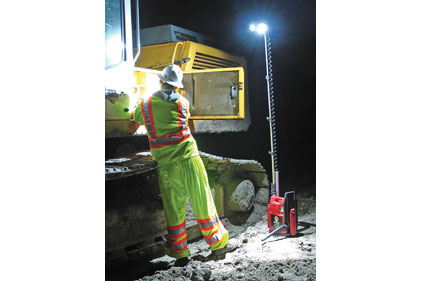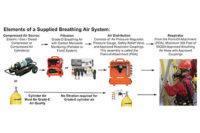Terminology
Most portable area lighting uses LED lights due to the low consumption of energy required to operate the lights. The energy being consumed to power the LED is measured in watts. The amount of visible light or brightness produced by the LED light is measured in lumens. The amount of lumens in a given area is called the lux value. The LED’s lens will determine the shape of the light pattern which can vary from a flood to a spot pattern.
Selection
LED lights vary from a single LED to a multi-head arrangement of lights. As the quantity of lights increase, the cost increases and battery run time decreases. Choose the combination of LED lights based on the job and use requirements and take into consideration any potential needs. An example is highway flagger illumination — a single LED lamp may meet federal and state illumination requirements, but a second head provides light needed for equipment maintenance.
The manufacturer’s warranty on the LED lamp heads can vary from a few years to a lifetime. The IP level is also important. IP stands for Ingress Protection; the first digit is for dust protection and the second digit for water protection. Is the manufacturer’s LED approved for use in wet weather or dusty environments? An IP rating of 68 would mean the LED lamp is completely dust-proof and can be submerged in water to a depth above one meter. Utility maintenance crews need to respond in all weather conditions, requiring high dust and water protection levels.
Set-up time: Is response time critical? If time is critical, it is important to select a unit that can easily be deployed with little to no set-up time and minimal parts to assemble. How many steps are required before the light is on? Can the light be deployed in the dark without tools? Assembly of parts or cord connections may interfere with valuable minutes in an emergency, so select an area light ready for operation without a lengthy set-up time.
Lamp head movement: Portable area lights should have the ability to elevate the LED lamp head(s). Elevated light allows for broader coverage and less opportunity for the light to be blocked by other equipment. In the case of a highway flagger, most states require overhead elevation of the lamp(s) so that the worker and the sign can be illuminated while reducing glare to oncoming traffic. For maintenance applications, having the lamp closer to overhead work areas can eliminate setting up larger lights and perhaps eliminate the expense of a second worker. Are the lamp heads independently adjustable? Light heads should have the ability to adjust in several directions.
Stability: If selecting area light for outdoor use, you should assume that not every location is going to be a level surface. Select a portable area light with extendable legs, rapidly deployable, to allow the light to be located on an elevated or angled surface. The legs should be made of stainless steel or a heavy plastic material to last in an industrial or outside setting. Support legs also allow the light to be able to stand up in high wind conditions.
Charging and use: The portable area light should have several different methods of charging the system. The basic charge system should be built into the unit and be able to charge from 110vac-240vac. An automatic trickle-charge feature is an excellent benefit for use when the battery is fully charged and has the ability to charge and operate the light simultaneously. If used at remote job sites or out of a vehicle, a DC charging connection (with cord supplied) to charge/run directly from a vehicle’s DC power port is a good feature. Some light systems offer a third charge feature with lugs to attach to a vehicle’s charge or jumper cables and get a direct charge from the battery. Another bonus is the DC power port can recharge/operate cell phones and laptop computers during power outages or when working in remote areas.
Make certain when buying a light that the manufacturer will service the light if needed, LED lamps are covered under a warranty, power options meet your needs, and buy from a reputable, established manufacturer.



